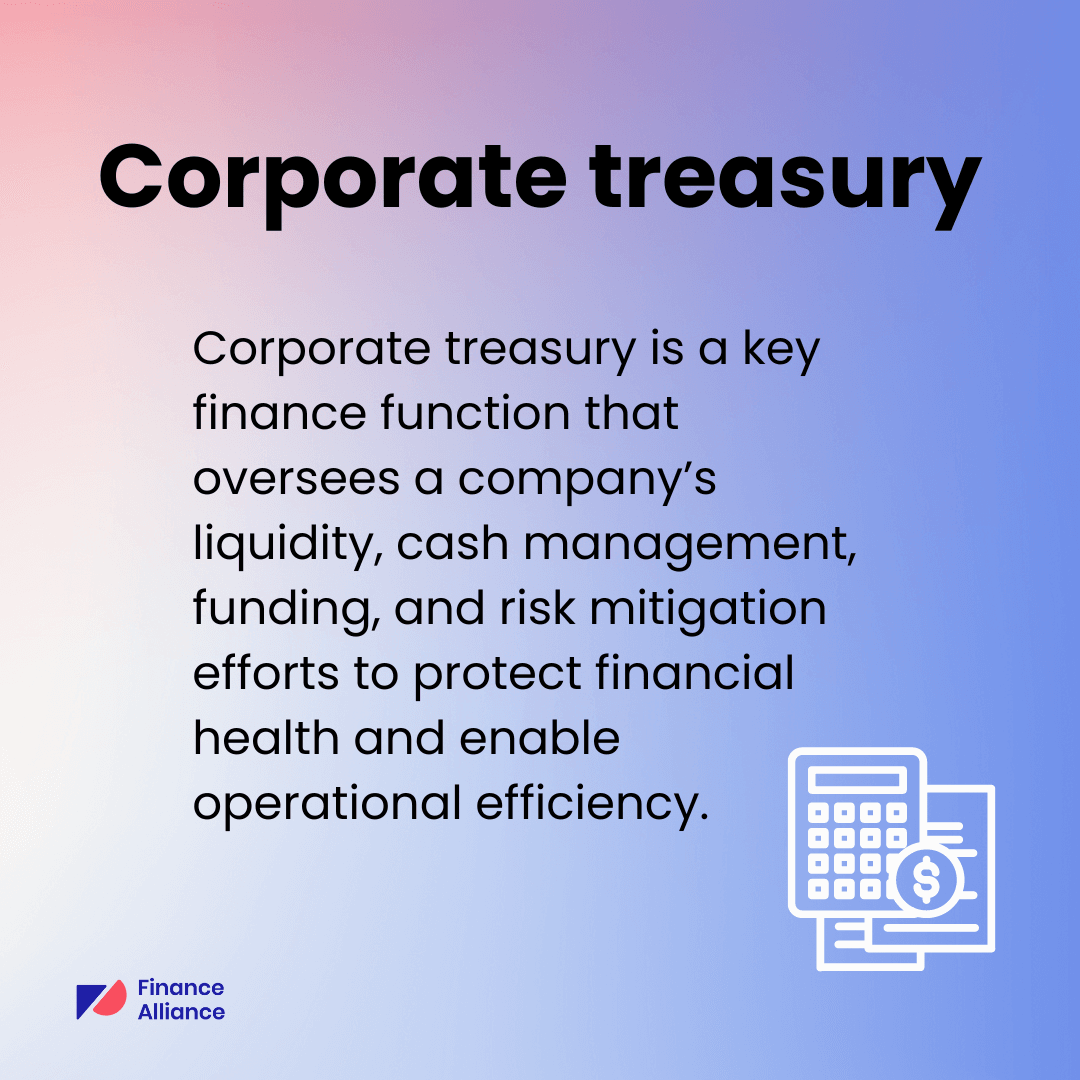Too often, companies make the mistake of sidelining corporate treasury as just another back-office function when it should be viewed as a key player in a company’s success.
An effective corporate treasury department is much more than cutting checks and keeping the books tidy. When managed properly, it becomes a strategic function that optimizes cash flow, mitigates risks, and ultimately, saves your company a fortune.

To find out how, keep reading as we cover the basics of corporate treasury and reveal three strategies to achieve this transformation.
Key takeaways:
- A strong treasury department is a valuable strategic partner within a company, not just a back-office function.
- Corporate treasury keeps the company on the financial straight and narrow - they make sure companies follow regulations properly.
- The core functions revolve around managing a company's liquidity, mitigating financial risks, and leveraging capital resources.
What is corporate treasury?
Corporate treasury refers to the division within a company responsible for managing financial resources and risks. They make sure the company has enough cash on hand to manage its day-to-day needs, invest funds wisely, and mitigate financial risks.

Treasury in a large vs small company
According to The Association of Corporate Treasurers (ACT), large businesses are likely to have a dedicated corporate treasury team “across multiple regions and countries that operate as part of a wider finance division.”
In small businesses, treasury probably isn’t going to have its own function or specific role. Instead, members of the finance team will likely “carry out specific treasury activities as part of their day-to-day responsibilities.”

Corporate treasury functions
While the functions of corporate treasury can vary across businesses, most of a treasurer’s core responsibilities fall under these key areas:
Corporate treasury cash management
This involves keeping track of all the money coming in and going out of the company. Treasurers also ensure there's enough liquidity to cover critical expenses like payroll and inventory purchases.
On a daily basis, treasurers determine the optimal cash positioning strategy. For example, they’ll decide how much cash to keep available for operational needs versus how much to invest to generate returns.
They’ll also manage the company’s bank. They’re often the ones deciding how much money to put in the bank, which helps the company prepare for any surprises and keep running smoothly.
Under the cash management umbrella, the treasury team:
- Forecasts cash needs
- Manages bank relationships
- Optimizes collection and payment processes
- Ensures sufficient liquidity to meet ongoing operational expenses
Funding and financing
Another important responsibility for corporate treasury functions is funding and financing. For example, treasurers may be responsible for obtaining loans from banks or selling bonds to investors.
They also make sure the company can pay back its loans and will help secure better interest rates. This helps the company afford big projects without running out of money.
Risk management
Corporate treasurers also protect the company from money problems and financial risks. They do this by keeping watch for things like changing interest rates or costs that could go up or down unexpectedly.
For instance, if they know the cost of borrowing money might go up, they can act early to lock in a lower rate. This keeps the company stable and avoids surprises in spending.
Managing investments
The treasury department acts as the bridge between the company and its financial partners. So, expect them to be the ones managing investor relations, especially for publicly traded companies. This involves working with the investor relations team to communicate with shareholders and analysts regarding the company's financial health.
With specific investment decisions, the corporate treasury department will develop and implement investment strategies for surplus cash, ensuring a balance between security and return.
Payments and collections
Ensuring smooth and efficient domestic and international payments to vendors and suppliers, as well as managing the collection of receivables from customers. This might involve:
- Payment optimization: Negotiating payment terms with suppliers to secure early payment discounts or extended payment periods to optimize cash flow.
- Collections strategy: Developing strategies to collect outstanding payments from customers quicker, potentially including implementing late payment fees.
Financial compliance
Ensuring financial compliance is a huge part of the role of a corporate treasurer, which means making sure the company adheres to all relevant financial regulations.
Foreign Exchange (FX) Management is also vital, and treasurers must monitor and mitigate the company’s exposure to currency fluctuations. To do this, they’ll often use hedging instruments like forwards or options contracts to lock in exchange rates for upcoming transactions.
In corporate treasury, it’s vital to stay up-to-date with (and ensure adherence to) international sanctions and trade regulations. This helps protect the company from legal and reputational risks connected with violating these regulations.
Treasury liquidity management
Although similar to cash management, liquidity management in treasury looks at a much bigger picture when it comes to a company’s financials.
Its main purpose is to make sure the company has enough liquid assets (easily convertible to cash) to meet short-term obligations. This goes beyond simply monitoring checking account balances and involves:
- Developing accurate forecasts of future cash inflows and outflows to anticipate potential shortfalls and excesses.
- Managing inventory levels, receivables, and payables to ensure the best use of working capital (and minimize the amount of cash tied up in non-liquid assets).
- Investing surplus cash in low-risk, highly liquid instruments to earn a return while ensuring the funds can be readily accessed if needed.
- Establishing and maintaining relationships with lending institutions to secure backup lines of credit in case of unexpected cash flow disruptions.

3 strategies to transform your corporate treasury department
As the CFO, you understand the critical role your corporate treasury team plays in protecting the company's financial state. However, by leveraging treasury as a strategic tool, you can help it drive even more value and improve financial performance in a big way.
Here are three strategies to consider:
1. Shorten the working capital cycle
Corporate treasury can experience snags when it comes to managing the working capital cycle and attempting to shorten it. Most of these hurdles are internal issues like disjointed processes within the finance function, inaccurate data, restricted visibility, and the inability to control the working capital management policy.
All of these issues can be a real headache. But, if you can successfully navigate these obstacles, corporate treasury can become a strategic advisor to the business and shorten the working capital cycle, which can help:
- Convert assets into cash quicker
- Build better liquidity and financial flexibility
- Reduce reliance on external financing
- Increase profitability
- Make the company’s operations more efficient
According to Deloitte's report, "The Strategic Corporate Treasurer: Backbone of a Successful Organization," three critical elements must be embedded within the corporate treasury framework to achieve a sustained shortening of the working capital cycle:
- Innovative financial solutions to unlock liquidity from receivables and inventory.
- Continuous monitoring of working capital metrics, blockages and leakages.
- Consultative and continuous engagement with the business and business finance.
By focusing on these core principles, corporate treasury can become a strategic partner in optimizing cash flow.
2. Leverage big data and predictive analytics
The finance function is usually drowning in data. In fact, the World Economic Forum estimates the amount of captured data at a staggering 44 zettabytes – 40 times more bytes than stars in the observable universe!
By 2025, this daily data deluge is expected to reach 463 exabytes globally. For corporate treasury departments, this presents both a challenge and a huge opportunity.
By leveraging big vast amounts of financial data from various sources (transactions, bank statements, market trends), you can gain deeper insights into things like cash flow forecasting, risk management and optimizing investments.
Predictive analytics can identify patterns and trends in cash inflows and outflows, which can help you create more accurate forecasts. In corporate treasury, this technology could potentially spot a currency fluctuation that could impact your overseas operations. By having that nudge in advance, the treasury department can then implement hedging strategies to help minimize potential losses.
This is just one example of how predictive analytics and big data can help improve corporate treasury. Of course, you’ll still need to make sure to invest in the right tools and build a data-driven culture so everyone has the necessary skills to interpret and utilize data insights to inform decision-making.
3. Foreign Exchange Exposure Netting
If you work for a large company that operates in more than one country, you’ll likely face significant foreign exchange (FX) risks.
Unfortunately, a slip-up can lead to significant transaction costs and vulnerability to currency fluctuations. This is where foreign exchange exposure netting proves useful.
So, what do we mean by FX exposure?
Let’s put this into context in the real world.
Imagine your company has a subsidiary in Europe that owes 1 million euros (EUR) to a supplier in three months. At the same time, you have a US-based customer who will pay you $1.2 million (USD) in three months.
On the surface, these transactions appear balanced. But, their value is subject to the exchange rate between EUR and USD at the time of settlement.
So, if the euro strengthens against the dollar in the next three months, you'll receive fewer euros for your US dollar receivables, which can impact your bottom line. This is FX exposure.
Foreign exchange exposure netting can help you:
- Reduce the overall number of FX transactions needed (and therefore help you save on costs such as conversion fees).
- Minimize the impact of currency fluctuations on your cash flow by offsetting exposures.
- Get a clear view of your net FX exposure across different currencies, which allows for better forecasting.
So, if we used this strategy in our example above, this is potentially how that might play out:
By netting your 1 million euro payable with your 1.2 million USD receivable (converted to euros at the current exchange rate), you eliminate your FX exposure on this specific transaction.
In turn, this eliminates the risk associated with euro fluctuations and simplifies your foreign exchange management.
Netting is a powerful tool, but it requires some preparation. For example, it’ll help if you can consolidate your foreign exchange data from all subsidiaries and business units to create a holistic view of your exposures.
For netting to work smoothly, you need to build clear communication protocols between your corporate treasury department and operating units to ensure timely updates on upcoming payables and receivables.
Corporate treasury FAQs
What is liquidity management in treasury?
Liquidity management in treasury involves managing the balance between a company's immediate cash needs and its investment opportunities. The goal is to ensure that the company can meet its short-term obligations while maximizing its financial returns.
What does treasury do in a company?
The treasury department manages the company’s cash, investments, and risk to stabilize the corporate finances. They handle debt issuance, capital structure decisions, risk management, and banking relationships.
What is corporate treasury management?
Corporate treasury management involves overseeing a company’s financial assets and holdings, with the aim to maximize the firm’s liquidity, make wise financial investments, and reduce financial risk.
What’s the difference between treasury bonds vs corporate bonds?
Treasury bonds are issued by the government and are considered risk-free, while corporate bonds are issued by companies and involve higher risk and potentially higher yields reflecting the creditworthiness of the company.
How can we improve our corporate treasury operations?
Improvements can be made by integrating advanced analytics for better decision-making, automating routine tasks to increase efficiency, and continuously training staff to keep up with financial strategies and technologies.
What is the difference between a bank and a corporate treasury?
A bank offers financial services to the public and handles deposits, loans, and investments, while a corporate treasury manages the financial operations and risks of a specific company.
What is the difference between corporate finance and corporate treasury?
Corporate finance deals with strategic financial decisions, mergers, acquisitions, and long-term financial planning, while corporate treasury focuses on day-to-day management of company funds, liquidity, and risk.
Does corporate treasury pay well?
Yes, corporate treasury positions typically offer competitive salaries that reflect the significant responsibilities of managing corporate finances and risk.
What is the role of a corporate treasurer?
The Corporate Treasurer is responsible for the company’s capital structure, financial risk management, liquidity, and for maintaining relationships with banks and financial institutions.
What is the role of treasury management in an organization?
The role of treasury management is to optimize the company’s liquidity, ensure financial obligations are met, manage financial risks, and support the overall strategic financial goals of the organization.
Is the corporate treasury front office?
Yes, corporate treasury can be considered a front office role since it involves decision-making that directly impacts the company’s financial strategy and interactions with external stakeholders.
Fast-track your financial career
Gain a competitive edge with our Pro+ membership, an exclusive subscription service tailored to help finance professionals reach success.
Gain exceptional training from industry veterans, access the latest resources, and connect with like-minded peers who share your passion for achievement.
With Pro+, you’ll possess all the tools and knowledge needed to overcome any challenge and excel in your financial career.



 Follow us on LinkedIn
Follow us on LinkedIn




